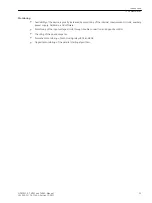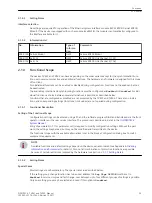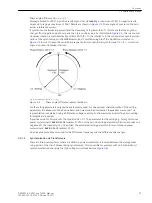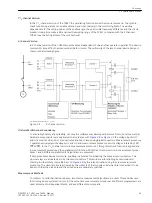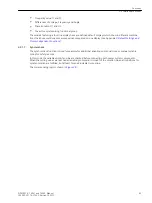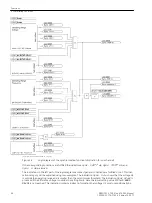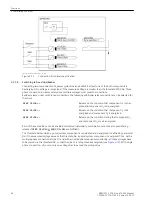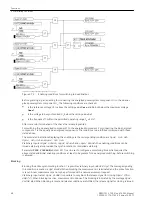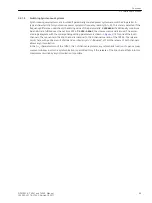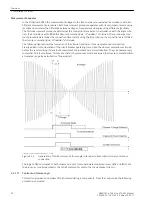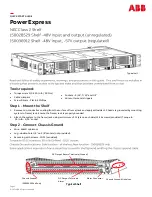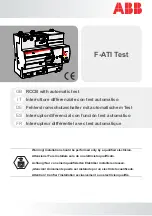
Phase angle difference dα = α2 – α1
Display is limited to ±180°. A positive result means that α2 leads by a maximum of 180°. A negative result
causes α2 to lag by a maximum of 180°. Details are shown in
. Phase angle α1 was set on the zero
axis as a reference system.
If synchronous networks are present and the frequency f2 is greater than f1, this means that the angle dα
changes from negative value to zero and then to a positive value. As illustrated in
clockwise rotation (= mathematically positive). With f2 < f1 the rotation is in the counter-clockwise. By visuali-
zation of the synchroscope in the WEB-Browser (see “Commissioning Aids”) the illustration is rotated in
in order to keep the usual phase sequence from conventional synchroscope (f2 > f1 — correction
angle in counter-clockwise rotation).
[ve6-phasenwinkeldifferenz-090403-oz, 1, en_GB]
Figure 2-5
Phase angle difference representation dα
For the setting parameters only positive values were used. For unequivocal characterisation of the setting
parameters the above mentioned value description was modified somewhat. Inequalities were used. The
representation is explained using a difference voltage example. To allow asymmetrical settings, two setting
thresholds are required.
A positive value for dU produces the condition U2 > U1. The parameter for the setting e.g. for asynchronous
power systems is
dU ASYN U2>U1
(address 6130). For the second setting parameter which corresponds to a
negative dU, the inequality U2 < U1 applies. The associated setting parameter for asynchronous power
systems is
dU ASYN U2<U1
(address 6131).
An analogous procedure was used for the difference frequency and the difference phase angle.
Synchronization via Transformers
There are also power systems where in addition a power transformer is located between the voltage meas-
uring points of the circuit breaker being synchronised. This is possible for example with unit connections if
synchronization is done using the high-voltage circuit breaker (see
).
2.2.1.2
Functions
2.2 Paralleling Functions
SIPROTEC 4, 7VE61 and 7VE63, Manual
37
C53000-G1176-C163-3, Edition 10.2017
Summary of Contents for SIPROTEC 4 7VE61
Page 8: ...8 SIPROTEC 4 7VE61 and 7VE63 Manual C53000 G1176 C163 3 Edition 10 2017 ...
Page 24: ...24 SIPROTEC 4 7VE61 and 7VE63 Manual C53000 G1176 C163 3 Edition 10 2017 ...
Page 142: ...142 SIPROTEC 4 7VE61 and 7VE63 Manual C53000 G1176 C163 3 Edition 10 2017 ...
Page 192: ...192 SIPROTEC 4 7VE61 and 7VE63 Manual C53000 G1176 C163 3 Edition 10 2017 ...
Page 222: ...222 SIPROTEC 4 7VE61 and 7VE63 Manual C53000 G1176 C163 3 Edition 10 2017 ...
Page 230: ...230 SIPROTEC 4 7VE61 and 7VE63 Manual C53000 G1176 C163 3 Edition 10 2017 ...
Page 256: ...256 SIPROTEC 4 7VE61 and 7VE63 Manual C53000 G1176 C163 3 Edition 10 2017 ...
Page 314: ...314 SIPROTEC 4 7VE61 and 7VE63 Manual C53000 G1176 C163 3 Edition 10 2017 ...
Page 316: ...316 SIPROTEC 4 7VE61 and 7VE63 Manual C53000 G1176 C163 3 Edition 10 2017 ...
Page 330: ...330 SIPROTEC 4 7VE61 and 7VE63 Manual C53000 G1176 C163 3 Edition 10 2017 ...

